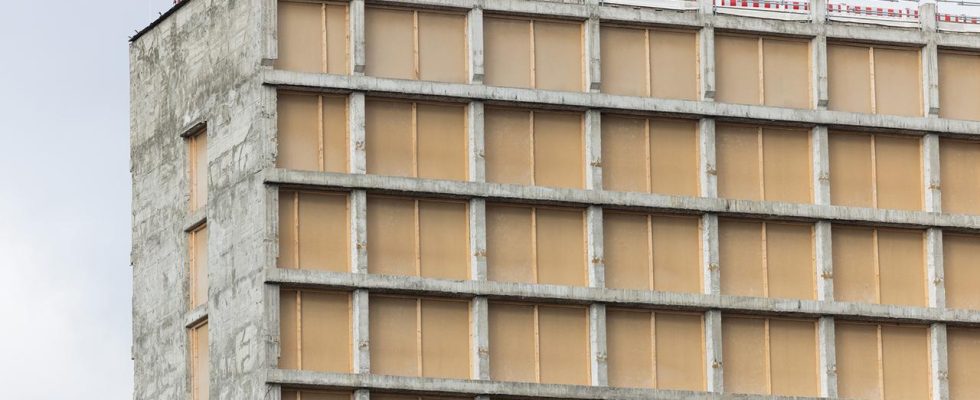Millions of tons of asbestos are in Germany’s buildings. They could now be released through the conversion of cities and energy-related renovations. A health risk, warns the IG BAU and calls for better occupational health and safety controls.
His face is a bit pale. But otherwise Werner Lüerß does not show that he has a serious lung disease. The 74-year-old has worked in construction in Berlin since the late 1960s. At that time, asbestos was almost ubiquitous on construction sites: “We lived in an asbestos world,” says Lüerß. He later became self-employed and removed asbestos from many residential buildings in Berlin after the building material was banned in Germany in 1993. His protective clothing with him: a painter’s suit and an FFP-1 mask.
In 2005 the diagnosis came: asbestosis – a hardening of the lungs caused by asbestos fibers. Once inhaled, they burrow deep into the tissue, causing chronic inflammation, hardened lung tissue, larynx, lung or pleura cancer. This has long been well documented. And yet Lüerß had to fight for years to get his asbestosis recognized as an occupational disease.
Asbestos is everywhere
Since numerous old buildings now have to be renovated as part of the energy policy, a lot of asbestos could be released again, warns the industrial union Bauen-Agrar-Umwelt (IG BAU). The possible consequence: a new wave of asbestos diseases. Because asbestos is built into many old buildings, in wall tiles, floors, pipes, window sills or balcony cladding, in cable or elevator shafts. The mineral fibers were added to cement, concrete, paint, glue or putty. This is mainly due to the fact that asbestos fibers seemed ideal for construction for a long time: strong, elastic, practically non-combustible – and inexpensive at the same time.
East and West Germany imported more than four million tons from the 1950s to the late 1980s. Around 9.4 million residential buildings are probably polluted throughout Germany. IG BAU has now had these figures collected by the Pestel Institute, which advises municipalities, associations and companies on the consequences of climate change and sustainable development, among other things.
Climate target and asbestos risk
If Germany wants to achieve its goal of being climate-neutral by 2045, the country now faces two decades of energy-efficient renovation and urban redevelopment. And with that, a lot of asbestos could be released, especially if the work is not done professionally. And even then the danger is not over.
“It is extremely difficult to create medically correct conditions on a construction site – and very expensive,” warns Torsten Bauer, chief physician at the Heckeshorn Lung Clinic at the Helios Clinic Emil von Behring in Berlin. Because the only thing that helps against asbestos-related lung diseases is not to breathe in asbestos. “I question whether that can always be guaranteed.” Bauer expects a second wave of asbestos disease in 20 to 30 years. How long can it take to get sick after inhaling asbestos? According to IG BAU, around 1,500 people are already dying each year from exposure to asbestos.
The professional, safe removal of asbestos is complex and expensive.
Technically complex
A specialist company is demonstrating just how much effort it can take to safely remove asbestos at a demonstration construction site in Berlin. The scenario: grinding work on the floor with exposure to asbestos. The floor on this demo construction site is not really contaminated with asbestos, but construction manager Marcel Herrfurth and his colleague journalists did not want to let them go to a real asbestos construction site: it is too harmful to health.
For safety reasons, there are always at least two of them when they work. In front of the room in which the asbestos floor would have to be removed if it were a real renovation site, the two have set up an airlock. There is a noisy industrial vacuum cleaner in the room. In the window they put a fan with multiple filters to create negative pressure. All this just so that no asbestos fibers from the construction site penetrate into the rest of the apartment.
The workers themselves slip into blue plastic overalls with a hood, put on overcoats over their shoes and gloves, which are secured to the overalls with extra tape. And then finally the breathing mask with special filters over the mouth and nose. The urgent advice of the two to all owners, house builders and allotment gardeners: Don’t do asbestos removal yourself! You can only do it wrong.
Cost five times higher than without asbestos
So much effort costs, of course: “20 to 25 euros per square meter,” says site manager Herrfurth. And without asbestos? “Five euros per square meter.” This is a huge cost problem, especially for city housing companies, which could have tens of thousands of “asbestos dwellings” in their inventory. A funding program from the federal, state and local governments to remove asbestos is needed, says IG BAU federal board member Carsten Burckhardt. “Those who create living space today must not get stuck at the expense of the old sins of the 50s, 60s and 70s.”
The trade unionist also calls for better education on the danger of asbestos and more intensive occupational health and safety controls. Lüerß, who after years on the construction site has been living with asbestosis for so long, is also fighting for this. He has become an activist and is campaigning with politicians in Berlin and Brussels for asbestos victims and their families to finally be recognized and adequately compensated.

